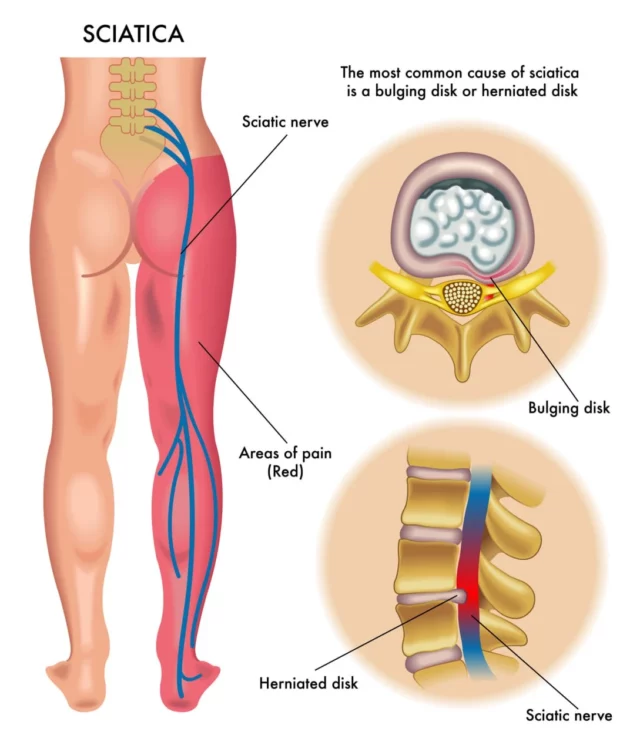If you can enjoy everyday actions such as standing, walking, or running, it’s thanks to the sciatic nerves, which run from your lower back down the back of your legs. Think of these nerves as a “freeway” for signals about sensation and movement from the lower part of your body to the brain and back.
When these nerves become trapped, irritated, inflamed, or damaged, they cause what’s known as sciatica, a painful condition that affects up to 40% of people at least once in their lifetimes. Although sciatica often resolves itself with adequate care, it can sometimes stem from more serious causes like tumors, bone overgrowth, and disc degeneration.
Because of this, it’s essential to seek an accurate diagnosis and a sustainable line of treatment as soon as your symptoms appear. In this guide, we’ll look at how the approach by NextPain Care can help you tackle chronic pain at the root of sciatica and pain in the buttocks. Let’s dive in!
Anatomy Of Sciatic Nerves
To understand the symptoms, causes, and outlook of sciatica, let’s start by looking at what sciatic nerves are and what happens when you develop sciatica.
Sciatic nerves are the longest and thickest nerves in the body, with a diameter of up to three-quarters of an inch. These nerves emerge from the sacral portion of the spinal cord (L4 to S3 nerve roots) in your lower back. From here, the two sciatic nerves run through the buttocks and down the backs of the legs to reach the feet.
Each sciatic nerve is actually a bundle of nerves that split off just below the knee to connect the different parts of the upper leg, lower leg, and foot to the central nervous system (the brain and spinal cord).
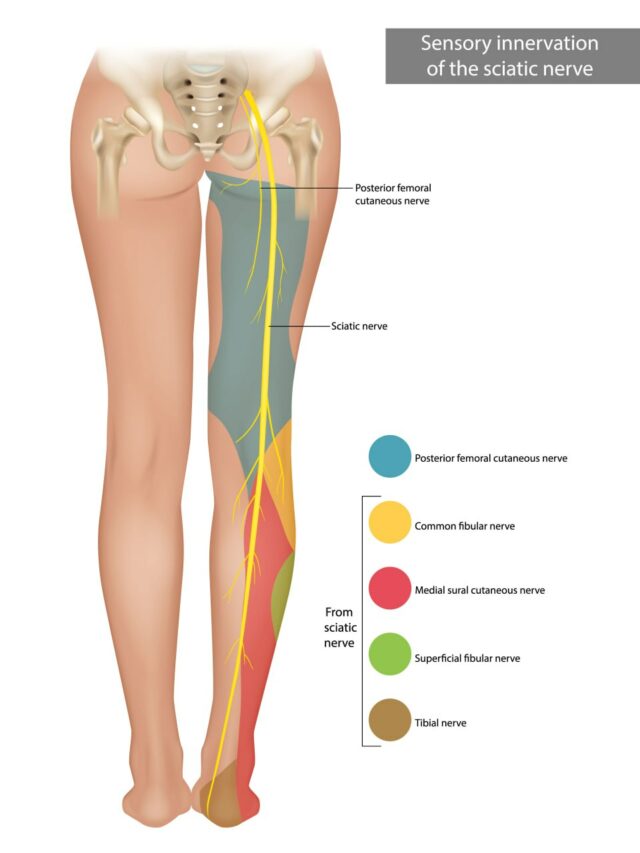
The main role of the sciatic nerve is to carry sensory and motor signals:
- Sensory signals relate to sensations like pain, vibration, temperature, and touch.
- Motor signals relate to muscle movements.
Sciatica refers to any medical condition or disorder that causes the sciatic nerves to become compressed, irritated, inflamed, or damaged. These conditions prevent the nerves from carrying signals to and from the brain as they should, which leads to nerve pain, numbness, and even temporary loss of movement.
Below, we’ll look at the symptoms, types, and causes of sciatica in more detail.
Sciatica And Pain In The Buttocks
If you’ve been struggling with pain in the buttocks that isn’t going away, or you’re experiencing numbness and loss of movement in the buttock area and upper leg, you might have sciatica or sciatica-like conditions.
Here’s the difference between the two:
- True sciatica: This refers to any condition that directly impacts one of the two sciatic nerves.
- Sciatica-like conditions: These are conditions that cause similar symptoms to sciatica but occur for other reasons, such as piriformis syndrome and inflammatory sacroiliitis (inflammation of the sacroiliac joint).
Sciatica and pain in the buttocks can interfere with your everyday life, cause temporary disability, and conceal more serious underlying conditions. To ensure you get adequate treatment promptly, let’s look at the symptoms and features of this condition.
Defining The Symptoms
One of the most common symptoms of sciatica is pain, which tends to have the following features:
- Sharp or stabbing sensations
- Localized on one side of the body (where the affected nerve is)
- Radiating from the buttocks down the hip and leg
- Intensifying after long periods of sitting, strenuous exercise, or when sneezing or coughing
As the sciatic nerve irritation worsens, you may begin to experience other symptoms, including numbness, tingling (“pins and needles” sensations), weakness, and temporary loss of movement.
A word of caution: The symptoms of sciatica may appear similar to those of cauda equina syndrome, which is a neurosurgical emergency requiring immediate intervention to avoid long-lasting neurological damage. If your buttock pain is accompanied by intense stabbing sensations, severe weakness, and loss of bladder or bowel control, seek immediate medical attention.
Where Else On The Body Does Sciatic Pain Occur?
Commonly, sciatica begins to develop as pain in the buttocks. Over time, as irritation of the sciatic nerve progresses, symptoms like pain, numbness, and tingling begin to spread along the length of the sciatic nerve.
In turn, you may begin to experience discomfort, weakness, and temporary loss of movement in your lower back, upper leg, lower leg, or foot.
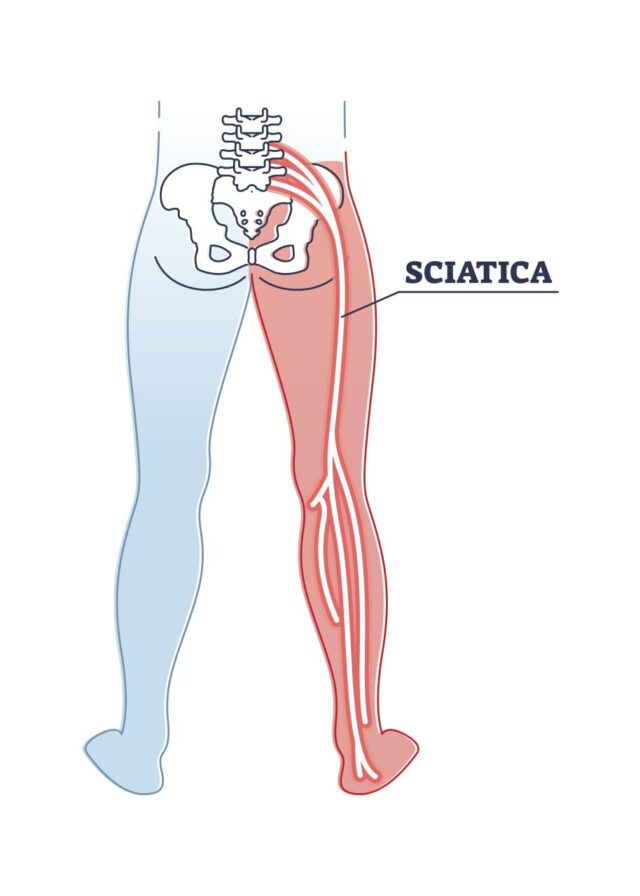
Role Of Sciatic Nerve In Spine/Lower Body Transmission
As mentioned earlier, the sciatic nerve is like a freeway: a bundle of several nerve fibers that carry signals to and from the brain. These signals relate to movement and sensations, such as pain and touch.
A pinched, irritated, or damaged sciatic nerve won’t be able to transmit signals as it’s supposed to, resulting in symptoms like extreme sensitivity to touch, nerve pain, numbness, and tingling.
In severe cases, damage to the sciatic nerve can interfere with the function of the nerves and muscles responsible for controlling the bladder and bowel. If you experience urinary or fecal incontinence, seek immediate medical care.
10 Common Causes Of Sciatica And Butt Pain
In most cases, sciatica is a temporary condition that improves within about 12 weeks without serious complications. However, pain in the buttocks can camouflage more serious, long-lasting conditions that require adequate treatment – including disc herniation, abnormal bony growths, and even tumors.

Because of this, it’s crucial to learn more about the causes of sciatica and determine the best line of treatment to avoid life-limiting complications. Let’s look at the most common conditions at the root of pain in the buttocks below.
1. Lumbar Disc Herniation
The spine is composed of small, circular bones known as vertebrae. These vertebrae are separated by intervertebral discs, which are cushions of cartilage that allow movements such as flexion, extension, and rotation and keep the spine flexible. They also protect the vertebrae from shock and friction damage.
Each intervertebral disc is composed of two main parts: an outer, stronger ring of cartilage and an inner, gel-like core. Although the intervertebral discs are incredibly reliable and capable of withstanding exceptional loads, factors such as overuse, aging, excessive stress, or injury can cause them to wear down.
When this happens, the outer ring of the intervertebral disc can become lax or crack, causing the softer core to protrude to nearby structures. Bulging or herniated discs can begin to press on, irritate, or damage adjacent spinal cord nerves, eventually leading to sciatica.
As the nerves are no longer able to transmit motor and sensory signals as expected, you may develop symptoms such as pain, numbness, and weakness.
2. Lumbar Spinal Stenosis (Nerve Compression)
Another common cause of sciatica is lumbar spinal stenosis. Spinal stenosis, or nerve compression, occurs due to the narrowing of the spinal canal, which is a cavity that houses the spinal cord. As this space in the spine narrows, the nerve roots are put under excessive pressure, which can interfere with the normal signaling of sensory and motor signals.
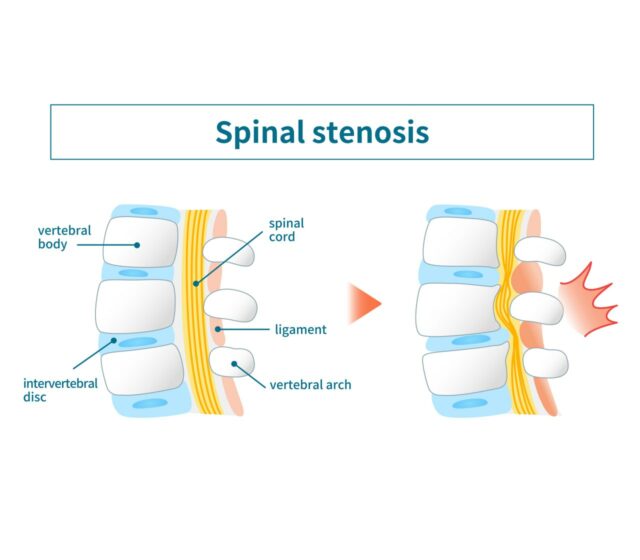
Spinal stenosis can occur due to several reasons and affects anyone at any age. However, some common causes include:
- The thickening and calcification of the ligaments that connect the vertebrae which tend to occur with aging and affect the spine’s flexibility
- Congenital factors, such as being born with a narrow spinal canal
- Injuries and trauma that change the course of the spinal canal
- Inflammatory diseases such as arthritis, which cause the swelling of nearby structures
- Abnormal bony growth
- Spinal tumors
Besides pain in the buttocks, lumbar spinal stenosis can cause a unique set of symptoms.
Increasing Pain Due To Nerve Compression
Spinal stenosis causes ongoing nerve compression, which leads to severe pain that radiates from the area affected (the lower back, in this case) to the upper and lower leg. When the nerve roots in the spine are compressed or damaged, they can also misfire, causing several neuropathic pain (nerve pain) conditions, such as:
- Allodynia: Allodynia refers to a condition that causes you to experience severe pain in response to stimuli that should normally be painless, such as dressing yourself or gently stroking your back.
- Hyperalgesia: Hyperalgesia causes excessive sensitivity to pain. This means that you may experience severe pain from stimuli that should only cause mild discomfort (such as pinching your back).
- Paresthesia: Alongside misfiring and causing pain, compressed spinal nerve roots may also not be able to transfer sensory signals to the brain. This can lead to symptoms such as weakness and numbness, as well as a condition known as paresthesia. Paresthesia refers to “pins and needles” sensations, which are often described as burning, prickling, itching, or “skin crawling” feelings. Depending on what nerve is affected by compression and irritation, these sensations can manifest in the hands, feet, buttocks, or other parts of the body.
3. Piriformis Syndrome
Accounting for only 0.6 to 3% of lower back pain cases, piriformis syndrome (PS) isn’t as common as disc herniation or spinal stenosis. PS can feel like sciatica but requires a different line of treatment to address the root cause of your pain in the buttocks.
PS is a neuromuscular condition that occurs when the piriformis muscle becomes inflamed or swollen and compresses the sciatic nerve. The piriformis muscle is a narrow, flat muscle that runs from the lower spine, through the buttocks, to the top of the thigh.
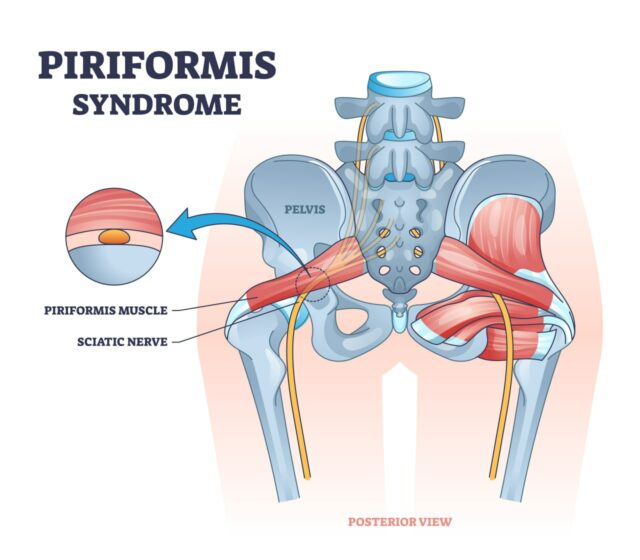
When this muscle becomes enlarged or tight, it presses on a specific area of the sciatic nerve, causing the pain and numbness to be localized to a certain site. The pain tends to become more intense during activities such as climbing stairs, walking, running, or sitting for long periods.
Common causes of PS include:
- Traumatic injury
- Overuse
- Muscle spasms
- Creation of scar tissue on the muscle
- Inflammation and swelling
- Poor muscle conditioning, having tight muscles, and limited physical activity
- Not maintaining proper form during exercise or not warming up or cooling down
4. Degenerative Disc Disease
Degenerative disc disease is widespread. Up to 35% of adults over 30 and up to 90% of people aged 60 show signs of this disorder. However, not everyone will experience symptoms, and only 5% of low back pain cases can be traced back to degenerative disc disease.
This disease occurs due to the natural, age-related degeneration of the intervertebral discs. While it may affect anyone and its incidence increases with age, there are also some risk factors that may speed up the degeneration of the discs. These are:
- Excessive stress on the spine (such as that caused by carrying excessive weight or being obese)
- Overuse (such as repetitive hyperextension or arching of the back)
- Smoking
- Suffering acute injuries
- Being female
- Lifestyle factors (such as performing repetitive, forceful movements with your spine at work or during sports)
Degenerative disc disease works similarly to herniated discs: as the intervertebral discs degenerate, the outer ring begins to protrude and crack, causing the inner gel-like substance to protrude and press on nearby spinal nerve roots.
The main difference is that degenerative disc disease is primarily caused by aging and wear and tear. Degenerative disc disease is also a common risk factor for herniated discs.
5. Sacroiliac Joint Dysfunction
The sacroiliac joint is located near the bottom of the spine, just above the tailbone, and connects the sacrum with the pelvis. It plays a vital role in stabilizing the spine during movements such as sitting or walking.
Dysfunction in the sacroiliac joint occurs when flawed or abnormal movements take place. These include:
- Misalignment of the joint during movement
- Hypermobility or instability
- Reduced mobility (hypomobility) or fixation
Sacroiliac joint dysfunction does not cause sciatica but can cause sciatica-like pain in the buttocks, lower back, and hips, and can radiate down the leg (usually above the knee, but it can sometimes also affect the ankle and foot).
Besides pain, this condition can also cause numbness, weakness, tingling sensations, disturbed sleeping patterns, and difficulty in sitting.
6. Tumors And Infections
In rare cases, sciatica and pain in the buttocks may be caused by tumors (abnormal growth of tissues) that press on and irritate the nerves within and around the spinal column. This can happen when the tumor is located near the spine or in the spinal canal. Some tumors that may appear as sciatic-like pain include:
- Sciatic notch dumbbell tumors
- Schwannoma
- Prostate gland tumor
- Spinal or sacral neoplasms
- Metastasis (cancer cells that have traveled from other parts of the body and get lodged in the spine)
Sciatica-like pain can also be caused by infections, such as blood vessel infections and spinal infections that develop into abscesses (swollen and infected masses).
7. Diabetes
Diabetes is considered the leading cause of peripheral neuropathy, or damage to nerves outside the brain and the spinal cord.
Today, up to 51% of people with diabetes are at risk of developing neuropathy. This is because the sharp rises and drops in blood sugar levels can eventually damage blood vessels. In turn, this can sever the supply of blood, oxygen, and nutrients to nerve endings, which, over time, degenerate and die.
Neuropathy can affect any nerve in the body and, although it is more common in the hands and feet, it can also affect the legs and buttocks, causing symptoms similar to those of sciatica (especially in the legs).
8. Trauma Or Injury
Trauma or injury can lead to sciatica, pain in the buttocks, or conditions that mimic the symptoms of sciatica (e.g. lumbar spinal stenosis). This happens when fractures, ligament or tendon ruptures, and joint dislocations change the body’s mechanics.
Over time, improper mechanics can cause you to put more pressure on a certain aspect of the joint and prevent the body from distributing loads properly while walking, running, jumping, or lifting weights. When the areas affected are the spine, hips, buttocks, or legs, the sciatic nerve can become abnormally compressed or irritated during movement, leading to sciatica and sciatica-like pain.
9. Obesity
Besides accounting for over 12% of the years of disability reported by people with chronic back pain, both obesity and being overweight have been seen to be major risk factors for sciatica and lumbar radicular pain.
There are several reasons for this:
- The increased weight you carry if you are obese or overweight puts the spine under excessive pressure, increasing the risk of disc herniation and degenerative disc disease.
- Obesity is a major risk factor for diabetes and arthritis, which may contribute to nerve pain and damage.
- Being obese can make it harder to exercise and lead an active lifestyle. Poor conditioning and limited flexibility can increase the risk of injuries and diseases like piriformis syndrome.
- Excessively fatty body composition is linked to increased systemic inflammation and chronic pain, which can aggravate pain in your buttocks.
Lastly, an unhealthy diet, excessive weight, and limited exercise can increase recovery time from sciatica and sciatica-like conditions.
10. Poor Posture And Body Mechanics
Sciatica-like pain in the buttocks, as well as true sciatica, can derive from poor posture and abnormal body mechanics.
Poor sitting or standing posture (such as slouching or leaning forward to your desk) can increase strain in your lower back. At the same time, structural problems such as scoliosis can expose certain components that should be unaffected during movement to friction damage.
If not corrected promptly, poor posture and body mechanics can lead to undue pressure on nerves (such as the sciatic nerve) and associated symptoms, such as pain, numbness, and weakness.
Contributing Factors And Risk Factors
Above, we’ve looked at some of the most common causes of sciatica and sciatica-like pain. However, there are also other risk factors that, over time, can significantly increase the likelihood of experiencing chronic pain in the buttocks.
Let’s look at these risk factors below.
Age And Degeneration
Intervertebral disc degeneration is a normal aspect of aging. Over time, the discs lose their suppleness and flexibility, which increases the risk of herniation, tears, and bulging discs that can press on the sciatic nerve.
While you can’t turn back the hands of time, there is a lot you can do to age healthily and control the rate at which intervertebral discs degenerate. For example, maintaining a healthy weight, eating healthily, and staying active are just some strategies to manage the complications of obesity, diabetes, and osteoarthritis – which are all risk factors for low back pain and pain in the buttocks.
Lifestyle Factors
Certain lifestyle factors increase your risk of developing sciatica or pain in the buttocks. These include:
- Limited physical activity: A sedentary lifestyle can make obesity more likely, while poor muscle conditioning increases the risk of injuries.
- Drinking alcohol and smoking cigarettes: Not only are these substances neurotoxic (toxic for nerves), but they also increase the risk of suffering from inflammatory diseases, obesity, diabetes, and cardiovascular diseases.
- Occupation and hobbies: You may be at greater risk of sciatica and pain in the buttocks if you often perform repetitive, forceful movements, such as heavy lifting, bending, jumping, and twisting.
Pregnancy and prolonged sitting can also put you at greater risk of developing sciatica or sciatica-like pain.
Injury And Trauma
Both new and old injuries can impact your risk of developing sciatica.
New injuries may cause damage to the body components located around the sciatic nerve, such as the hip, leg, pelvis, or buttocks. Traumatic injury can compress or damage the sciatic nerve, leading to temporary symptoms.
An old injury that hasn’t properly healed may have similar consequences. If a fracture, dislocation, or surgical intervention has permanently changed certain aspects of your body’s mechanics, you may be inadvertently putting unexpected pressure on your sciatic nerve during daily activities.
Conventional Treatment Options
If you’ve been struggling with sciatica or pain in the buttocks, you may have been recommended conventional treatments such as medications, physical therapy, or, in severe cases, surgery.
These treatments may help manage your pain and discomfort, providing relief when combined with proper assessments, personalized treatments, and comprehensive care tailored to your specific needs. Understanding the pros and cons of these options is the first step toward finding a solution that works for your unique needs.
Non-Surgical Treatments
Non-surgical treatments are often the first port of call when you develop sciatica. After a few days of rest, you may use medications, physical therapy, and at-home remedies to manage the pain.
- Medications: Pain medications for sciatica include over-the-counter painkillers and NSAIDs (non-steroidal anti-inflammatory pharmaceuticals) like ibuprofen.
- Physical therapy: Physical therapy can help you regain movement in your lower body if you are affected by sciatica. It may also help increase muscle strength in your core and back, reducing the risk of recurring episodes of sciatica.
- Chiropractic care: Spinal adjustments and massages may help reduce pressure on the sciatic nerve, easing pain and discomfort. While this method is non-invasive, there is little evidence of its effectiveness in relieving sciatica and sciatic-like pain.
- Warm and cold packs: During the first few days after an injury, ice packs may help relieve swelling and pain, which can help you regain mobility in your legs and buttocks. If sciatica continues for weeks or months, warm compresses may help stimulate blood flow and relax tense muscles, providing temporary relief.
Surgical Treatments
If you’ve been struggling with sciatica for months and other treatments haven’t provided the relief you hoped for, your doctor may suggest surgery. Before making this decision, it’s important to understand the potential risks: generally, the more invasive the procedure, the greater the risk of complications.
Two common surgical treatments for sciatica are:
- Discectomy: Discectomy (or microdiscectomy) is a surgical procedure to relieve the pressure on the sciatic nerve caused by a herniated disc. During surgery, your doctor will remove parts of the intervertebral discs that are bulging out to prevent further irritation or damage to the sciatic nerve.
- Laminectomy: Laminectomy relieves the pressure on the sciatic nerve caused by spinal stenosis. In this procedure, part of the vertebral bone (lamina) is removed to create a larger canal for the spinal cord and nerve roots.
Preventive Measures
Although sciatica and pain in the buttocks can affect anyone at any age, there are preventive strategies you can use to reduce the risk of this condition becoming a chronic problem.
These measures can also help you recover quickly from an episode of sciatica and boost the effectiveness of your chosen treatment.
Avoid Prolonged Sitting
Sitting is a normal part of our daily lives. Whether you work at a desk, spend hours gaming or watching TV, or enjoy a sedentary hobby, you may inadvertently spend much of your day sitting.
However, it’s important not to underestimate the impact that sitting too much can have on your musculoskeletal and spinal health. Firstly, your entire upper body rests on your lower back while sitting. This can increase the pressure on your buttocks and cause sciatica-like pain.
The poor posture you may adopt while sitting can also further compress your spine’s vertebrae, speeding up disc degeneration and increasing the risk of herniated or bulging discs. Lastly, prolonged sitting can weaken your back and core muscles, making injuries more likely.
You don’t need to revolutionize your lifestyle to cut down on sitting. Instead, try to introduce progressive changes, such as:
- Taking active breaks at work
- Practicing yoga or tai chi while at your desk
- Investing in a walking pad
- Walking or cycling to work
- Spending time outdoors with your pets or kids
- Joining active initiatives and hobbies, such as gardening, beach cleaning, and dog walking
Stay Active And Stretch
To prevent sciatica, another piece of the puzzle is physical activity and stretching. Boosting your muscle conditioning, endurance, and flexibility can help you avoid injuries and disorders such as piriformis syndrome.
Regular exercise is also key to keeping at bay several risk factors for sciatica, nerve pain, and pain in the buttocks, such as obesity, diabetes, osteoarthritis, and cardiovascular diseases.
Strengthen Core Muscles
Your back and core muscles work together to enable spinal movements, maintain stability during movement, and prevent injuries that may arise from overextension or excessive rotation.
When your back muscles are weak, your body will rely on other, weaker structures to support these functions, such as ligaments and tendons. This can increase the risk of injuries and misalignments that can lead to chronic pain.
Strengthening your core muscles is an efficient way to support spinal movements, protect the spine, maintain a neutral pelvic tilt, and reduce stress on structures like the vertebrae or intervertebral discs.
Reduce Excessive Stress On Your Lower Back
Excessive stress on your lower back can derive from multiple sources, including:
- Poor posture
- Sitting too much
- Repetitive movements
- Being obese
To decompress your lower back and find long-lasting relief from pain, work on losing excess weight, adopt a better posture, and work with an occupational therapist to prevent your job or hobby from compromising your spinal health.
NextPain Care Treatment For Sciatica And Buttock Pain

When it comes to overcoming chronic pain in your lower back and buttocks and finding a sustainable treatment that can help you regain your mobility and health, it’s crucial to address the underlying issues.
Systemic inflammation can speed up the degeneration of intervertebral discs and increase the risk of spinal components becoming swollen and painful. Fortunately, it’s possible to reduce chronic pain effectively.
Our approach aims to reduce pain caused by inflammation, promoting lasting relief from chronic pain. We start with gentle, minimally invasive therapies to alleviate muscle tension and support healing. If these initial therapies are not sufficient, our physician-led multidisciplinary team can offer advanced interventions to enhance pain relief.
By creating personalized treatment plans tailored to your needs, we ensure comprehensive care. Throughout your treatment, we maintain a supportive and compassionate environment, helping you focus on your journey to improved health and mobility.
Efficiently Address Your Pain At The Earliest Opportunity
Sciatica and pain in the buttocks can lead to temporary disability and rob you of several days of productivity and enjoyment. Efficiently addressing your pain at the earliest opportunity is crucial for optimal recovery and long-term health. At NextPain Care, we believe in early intervention to prevent the progression of pain and discomfort. Let us help you start on your path to pain relief.
Address sciatica with a thorough approach.

